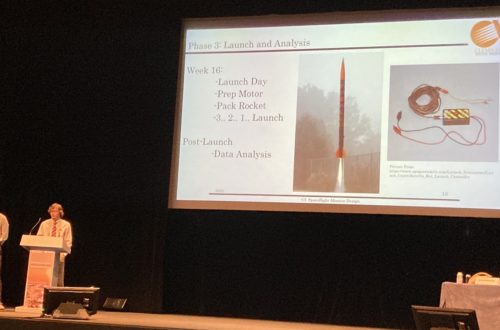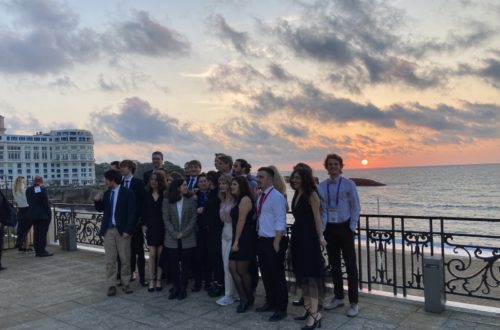Peter J. McNulty – faculty member and department chair
August 10, 2022
August 10, 2022
July 7, 2022
The Sonoco FRESH initiative at Clemson University has awarded three research grants to professors who are addressing issues regarding the safety, security, and sustainability of food throughout the value chain. With funding provided by Sonoco (a global provider of a variety of consumer packaging, industrial products, protective packaging, and displays and packaging supply chain services), each project focuses on how packaging can extend the shelf life of food, with particular emphasis on perforation density, recyclable adhesives and gas permeability.
Among the faculty members receiving the research grants is Assistant Professor of Physics and Astronomy, Dr. Rama Podila
“Sonoco has been honored to sponsor several calls for research proposals to be funded through Sonoco FRESH,” said Jeff Schuetz, Staff Vice President, Global Technology at Sonoco and FRESH Advisory Board Chair. “The unique multi-disciplinary FRESH research program recognizes the importance of developing solutions and we encourage companies at each step of the food value chain to support this program.”
June 8, 2022
Dr. Lu’s proposal to the NSF Grand Challenges in Integrative Geospace Sciences program, Advancing National Space Weather Expertise and Research award Societal Resilience (ANSWERS), has been awarded. This grant will support a multidisciplinary team led by Dr. Lu to study space weather – in particular they will explore how terrestrial weather events originating at lower altitudes and the solar wind lead to variations in space weather. The principle driver behind this work is developing the tools to better predict space weather and ameliorate the damage that can result. This award from NSF provides $900k over three years to advance this work as well as support the development of a new space weather curriculum. Please join me in congratulating Dr. Lu and her team for their success. I’m sure we all eagerly anticipate learning about the results of this work in the near future.
June 8, 2022
Professor Yao Wang was awarded a DOE Early Career Award for a proposal titled, “Analog Quantum Simulation for Solid-State Spectroscopies”. He has proposed to develop analog quantum simulation protocols for spectroscopy of quantum materials and extend this work to the simulation of spectroscopy of laser-engineered non-equilibrium matter. Quantum materials are characterized by having entangled electrons that behave in ways that cannot be described classically. Engineering such materials opens the door to developing novel types of superconductors and batteries, but to take full advantage of these possibilities, it is crucial to accurately and efficiently characterize the properties of the electrons. Classical computers are not capable of running such simulations, but quantum computers will be able to do so. The protocols developed by this work will enable theorists to harness the power of quantum machines that will be available in the near term. Dr. Wang’s work will transform our knowledge of exotic materials and has the potential to lead to breakthrough discoveries in superconductors, energy storage, and quantum devices.
The DOE Early Career Award are “a part of the DOE’s long-standing efforts to develop the next generation of STEM leaders who will solidify America’s role as the driver of science and innovation around the world.” This year 83 awards were granted to faculty at 47 different universities and 13 national labs. These awards provide $750k over five years that in the words of U.S. Secretary of Energy Jennifer M. Granholm, “…[allows] the recipients the freedom to find the answers to some of the most complex questions as they establish themselves as experts in their fields.”
Please join me in congratulating Dr. Wang for this great honor. I’m sure we all look forward to seeing the results of this work.
June 2, 2022
German radio journalist Kristian Thees and German actress and entertainer Anke Engelke, talk about the NASA sounding rocket experiment INCAA and the image of tracer releases in Alaska submitted by listener Prof. Gerald Lehmacher, who was co-investigator for the experiment. Prof. Steve Kaeppler and Prof. Miguel Larsen were principal investigator and co-investigator, respectively. The photo taken by Danute Paukstys from Wasilla, Alaska is featured in the podcast’s blog and discussed (in German) in the episode of May 26, 2022 (starting at about 8:50 min). Two sounding rockets were successfully launched on April 7, 2022 from Poker Flat, Alaska to study ion-neutral coupling under active aurora. The payloads carried experiments from the University of California Berkeley, the University of Calgary and Clemson University.

June 2, 2022
Clemson undergraduates Austin Smith and James Hutchinson presented the student rocket experiments carried out under the supervision of Prof. Steve Kaeppler and graduate student Alvaro Guerra over the last two semesters at the 25th ESA Symposium for European Rocket and Balloon Programmes and Related Research in held on May 1-5, 2022 in Biarritz, France. Their oral presentation entitled “Clemson University Student Space Program: Educating Students in the Field of Space Physics” was given in the “Rockets & Balloons in Space Education” session and received broad attention and feedback from scientists and students in the audience.



March 21, 2022
Please join me in congratulating Yang Yang for being awarded a Harvard-SAO Predoctoral Fellowship. Over the past few years, several PhD students from our department have had the opportunity to work at other research institutions as part of their graduate education. Yang Yang is the fourth student in recent years (joining Amy Gall, Xiuriu Zhao, and Jordan Eagle) to be awarded this prestigious fellowship. Kudos to Prof. Takacs for the mentorship and support he has provided to help Ms. Yang achieve this opportunity. At the SAO she will use their electron beam ion trap to generate laboratory astrophysics atomic data for AtomDB, the databased maintained by SAO for the analysis of astrophysical spectra. She works closely with one of our alums, Dr. Gall, and is involved in collaborative work with the University of Georgia and Auburn University funded by NASA. This is a very exciting achievement for Ms. Yang!
March 1, 2022
August 17, 2017 was a watershed moment for multimessenger astronomy when the gravitational waves and photons from a kilonova were detected for the first time. And GW170817 continues to surprise. A kilonova results from the merger of neutron stars and is thought to be the source of heavy elements such as gold.
Our colleague, Prof. Jon Zrake, was part of team that has monitored the evolution of X-rays from this source. Initially the source was fading, but in 2020 the fading stopped and has remained relatively constant since. This provides intriguing insight to the physics of neutron star mergers and the subsequent explosion. The behavior of the X-rays is somewhat puzzling, and this team has proffered two explanations to account for the behavior – one possibility is that we are seeing the afterglow of the kilonova. Another possibility is that we seeing the accretion signature of material falling into a blackhole formed by the merger of these neutron stars. If the constant brightness is due to an afterglow, we should see the source brighten again. If the result is due to accretion into the black hole, then the source should remain constant or fade away over the next few years. Either result will provide valuable insight to the physics of kilonova. This work was published in the Astrophysical Journal Letters and can be accessed here.
March 1, 2022
Alan Rowland, a first year Physics Ph.D. student, and Dylan Carroll, a genetics major, were finished second and third respective in SCBIO’s “Challenge Accepted” video competition. They developed videos highlighting their work in Dr. Podila’s lab. They described their work developing COVID-19 and tuberculosis sensors using smartphones. This work will increase access to such tests for people around the world. Read more about their fascinating work here.